
The Standardbred is an American horse breed best known for its ability in harness racing, where members of the breed compete at either a trot or pace. Developed in North America, the Standardbred is recognized worldwide, and the breed can trace its bloodlines to 18th-century England. They are solid, well-built horses with good dispositions. In addition to harness racing, the Standardbred is used for a variety of equestrian activities, including horse shows and pleasure riding, particularly in the Midwestern and Eastern United States and in Southern Ontario.
A color breed refers to groupings of horses whose registration is based primarily on their coat color, regardless of the horse's actual breed or breed type.

The Arabian or Arab horse is a breed of horse that originated on the Arabian Peninsula. With a distinctive head shape and high tail carriage, the Arabian is one of the most easily recognizable horse breeds in the world. It is also one of the oldest breeds, with archaeological evidence of horses in the Middle East that resemble modern Arabians dating back 4,500 years. Throughout history, Arabian horses have spread around the world by both war and trade, used to improve other breeds by adding speed, refinement, endurance, and strong bone. Today, Arabian bloodlines are found in almost every modern breed of riding horse.

The Icelandic horse is a breed of horse developed in Iceland. Although the horses are small, at times pony-sized, most registries for the Icelandic refer to it as a horse. Icelandic horses are long-lived and hardy. In their native country they have few diseases; Icelandic law prevents horses from being imported into the country and exported animals are not allowed to return. The Icelandic displays two gaits in addition to the typical walk, trot, and canter/gallop commonly displayed by other breeds. The only breed of horse in Iceland, they are also popular internationally, and sizable populations exist in Europe and North America. The breed is still used for traditional sheepherding work in its native country, as well as for leisure, showing, and racing.

The Mangalarga Marchador is a Brazilian breed of riding horse. It is the national horse breed of Brazil, where there are more than half a million of them; it is among the most numerous breeds of riding horse in the world. It derives from cross-breeding of Portuguese Alter Real horses with local Criollo stock. It displays four gaits: the walk, the canter, and two ambling gaits, the marcha batida and the marcha picada; it does not trot.

The Morgan horse is one of the earliest horse breeds developed in the United States. Tracing back to the foundation sire Figure, later named Justin Morgan after his best-known owner, Morgans served many roles in 19th-century American history, being used as coach horses and for harness racing, as general riding animals, and as cavalry horses during the American Civil War on both sides of the conflict. Morgans have influenced other major American breeds, including the American Quarter Horse, Tennessee Walking Horse and the Standardbred. During the 19th and 20th centuries, they were exported to other countries, including England, where a Morgan stallion influenced the breeding of the Hackney horse. In 1907, the US Department of Agriculture established the US Morgan Horse Farm near Middlebury, Vermont for the purpose of perpetuating and improving the Morgan breed; the farm was later transferred to the University of Vermont.The first breed registry was established in 1909, and since then many organizations in the US, Europe and Oceania have developed. There were estimated to be over 175,000 Morgan horses worldwide in 2005.

The American Saddlebred is a horse breed from the United States. This breed is referred to as the "Horse America Made". Descended from riding-type horses bred at the time of the American Revolution, the American Saddlebred includes the Narragansett Pacer, Canadian Pacer, Morgan and Thoroughbred among its ancestors. Developed into its modern type in Kentucky, it was once known as the "Kentucky Saddler", and used extensively as an officer's mount in the American Civil War. In 1891, a breed registry was formed in the United States. Throughout the 20th century, the breed's popularity continued to grow in the United States, and exports began to South Africa and Great Britain. Since the formation of the US registry, almost 250,000 American Saddlebreds have been registered, and can now be found around the world, with separate breed registries established in Great Britain, Australia, continental Europe, and southern Africa.

The Tennessee Walking Horse is a breed of gaited horse known for its unique four-beat running-walk and flashy movement. It is a popular riding horse due to its calm disposition, smooth gaits and sure-footedness. The Tennessee Walking Horse is often seen in the show ring, but is also popular as a pleasure and trail riding horse using both English and Western equipment. The Tennessee Walking Horse is also seen in movies, television shows and other performances.

The Narragansett Pacer was the first horse breed developed in the United States, but is now extinct. It was developed in the United States during the 18th century and associated closely with the state of Rhode Island, and it had become extinct by the late 19th century. The Pacer was developed from a mix of English and Spanish breeds, although the exact cross is unknown, and they were known to and owned by many famous personages of the day, including George Washington. Sales to the Caribbean and cross-breeding diminished the breed to the point of extinction, and the last known Pacer died around 1880.

The Canadian horse is a horse breed from Canada. It is a strong, well-muscled breed of horse, usually dark in colour. The horses are generally used for riding and driving. Descended from draft and light riding horses imported to Canada in the late 1600s, it was later crossed with other British and American breeds. During the 18th century the Canadian horse spread throughout the northeastern US, where it contributed to the development of several horse breeds. During the peak popularity of the breed, three subtypes could be distinguished, a draft horse type, a trotting type and a pacing type. Thousands of horses were exported in the 19th century, many of whom were subsequently killed while acting as cavalry horses in the American Civil War. These exports decreased the purebred Canadian population almost to the point of extinction, prompting the formation of a studbook and the passage of a law against further export.
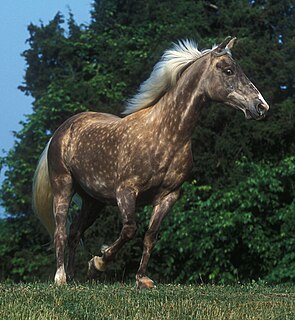
The Rocky Mountain Horse is a horse breed developed in the state of Kentucky in the United States. Despite its name, it originated not in the Rocky Mountains, but instead in the Appalachian Mountains. A foundation stallion, brought from the western United States to eastern Kentucky around 1890, began the Rocky Mountain type in the late 19th century. In the mid-20th century, a stallion named Old Tobe, owned by a prominent breeder, was used to develop the modern type; today most Rocky Mountain Horses trace back to this stallion. In 1986, the Rocky Mountain Horse Association was formed and by 2005 has registered over 12,000 horses. The breed is known for its preferred "chocolate" coat color and flaxen mane and tail, the result of the relatively rare silver dapple gene acting on a black coat, seen in much of the population. It also exhibits a four-beat ambling gait known as the "single-foot". Originally developed as a multi-purpose riding, driving and light draft horse, today it is used mainly for trail riding and working cattle.
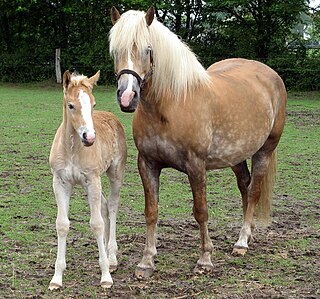
The Haflinger, also known as the Avelignese, is a breed of horse developed in Austria and northern Italy during the late 19th century. Haflinger horses are relatively small, are always chestnut with flaxen mane and tail, have distinctive gaits described as energetic but smooth, and are well-muscled yet elegant. The breed traces its ancestry to the Middle Ages; several theories for its origin exist. Haflingers, developed for use in mountainous terrain, are known for their hardiness. Their current conformation and appearance are the result of infusions of bloodlines from Arabian and various European breeds into the original native Tyrolean ponies. The foundation sire, 249 Folie, was born in 1874; by 1904, the first breeders' cooperative was formed. All Haflingers can trace their lineage back to Folie through one of seven bloodlines. World Wars I and II, as well as the Great Depression, had a detrimental effect on the breed, and lower-quality animals were used at times to save the breed from extinction. During World War II, breeders focused on horses that were shorter and more draft-like, favored by the military for use as packhorses. The emphasis after the war shifted toward animals of increased refinement and height.

An ambling gait or amble is any of several four-beat intermediate horse gaits, all of which are faster than a walk but usually slower than a canter and always slower than a gallop. Horses that amble are sometimes referred to as "gaited", particularly in the United States. Ambling gaits are smoother for a rider than either the two-beat trot or pace and most can be sustained for relatively long periods, making them particularly desirable for trail riding and other tasks where a rider must spend long periods in the saddle. Historically, horses able to amble were highly desired for riding long distances on poor roads. Once roads improved and carriage travel became popular, their use declined in Europe but continued in popularity in the Americas, particularly in areas where plantation agriculture was practiced and the inspection of fields and crops necessitated long daily rides.
The Racking Horse is a horse breed derived from the Tennessee Walking Horse, recognized by the USDA in 1971. It is known for a distinctive singlefoot gait. In 1971, the Racking Horse Breeders' Association of America, headquartered in Decatur, Alabama, was formed as the breed registry. Its goal is to preserve the breed in a natural state with little or no artificial devices that enhance gait. The horse's tail is naturally raised without nicking or tail sets. Some classes allow special shoes that enhance action, and a relatively newer class allows the use of chains, six ounces and under as action devices. The practice of soring, illegal under the Horse Protection Act of 1970, is also seen within the Racking Horse world. Since the breed's inception, about 80,000 Racking Horses have been registered, with the largest populations located in the US states of Alabama and Tennessee.
The American Walking Pony is a modern American breed of gaited riding pony. It was created by crossbreeding of the Tennessee Walking Horse and the Welsh Pony. Originally developed in Georgia, the breed was established in 1968 after several years of selective breeding. Joan Hudson Brown is credited as the founder of the breed and was the first executive secretary of the breed registry. The original breeding goal was to combine the smooth gait of the Tennessee Walker with the small size and refinement of the Welsh pony. Any combination of the two breeds is acceptable for the registry.
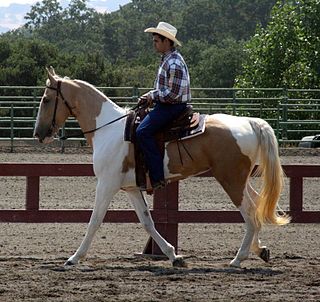
The Spotted Saddle Horse is a horse breed from the United States that was developed by crossing Spanish-American type gaited pinto ponies with gaited horse breeds, such as the Tennessee Walking Horse. The result was a colorful, smooth-gaited horse, used in the show ring and for pleasure and trail riding. Two registries have been created for the breed, one in 1979 and the other in 1985. The two have similar registration requirements, although one has an open stud book and the other is slightly more strict with regard to parentage requirements, having a semi-closed stud book. The Spotted Saddle Horse is a light riding horse, always pinto in color. Solid-colored foals from registered parents may be registered for identification purposes, so their pinto-colored foals have documented parentage. They always perform an ambling gait, rather than a trot, in addition to the gaits of walk and canter, performed by all breeds.
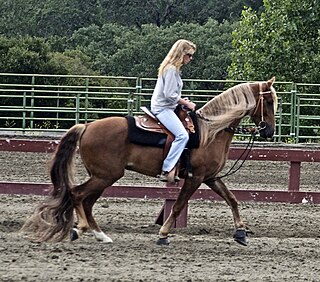
The Kentucky Mountain Saddle Horse is a horse breed from the U.S. state of Kentucky. Developed as an all-around farm and riding horse in eastern Kentucky, it is related to the Tennessee Walking Horse and other gaited breeds. In 1989 the Kentucky Mountain Saddle Horse Association (KMSHA) was formed, and in 2002, the subsidiary Spotted Mountain Horse Association (SMHA) was developed to register Kentucky Mountain Saddle Horses with excessive white markings and pinto patterns. Conformation standards are the same for the two groups of horses, with the main difference being the color requirements. The KMSHA studbook is now closed to horses from unregistered parents, although it cross-registers with several other registries, while the SMHA studbook remains open.
The Pinto Horse Association of America (PtHA) registers horses, utility horses, ponies and miniature horses of various pedigrees with certain kinds of pinto coat colors. The word pinto is Spanish for "paint." In general terms, pinto can apply to any horse marked with unpigmented pink-skinned, white-haired areas on its coat. The Pinto Horse Association of America provides the owners and riders of pintos with a show circuit and a breed organization. The primary requirement for PtHA registration is coat color; the pinto is not a true breed, but a color breed.
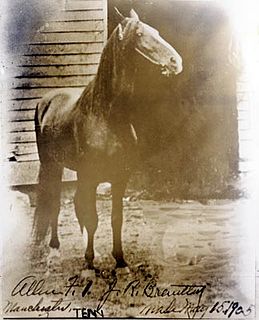
Black Allan or Allan F-1 was the foundation sire of the Tennessee Walking Horse. He was out of a Morgan mare named Maggie Marshall and by Allendorf, a stallion descended from Narragansett Pacer, Canadian Pacer, and Gaited Spanish Mustang imported from Texas. Black Allan was registered as No. 7623 by the American Trotting Registry. Although Black Allan was supposed to be a trotter, he preferred to pace and so never raced. Besides the pace, he performed a lateral ambling gait now known as the running walk. He was a black stallion standing 15 hands, 5 feet high. He was given the designation Allan F-1 when the Tennessee Walking Horse Breeders' Association, precursor to the Tennessee Walking Horse Breeders' and Exhibitors' Association, was formed in 1935. He had multiple owners throughout his life, but his last owners, James Brantley and Albert Dement, were the only ones to recognize Black Allan's use as a breeding stallion. Black Allan sired 111 known foals in his lifetime, among them Roan Allen, registration number F-38, Hunters Allen F-10, and Merry Legs F-4. Black Allan died September 16, 1910, at the age of 29.

The horse industry in Tennessee is the 6th largest in the United States, and over three million acres of Tennessee farmland are used for horse raising or horse-related activities. The most popular breed in the state is the eponymous Tennessee Walking Horse, and it became an official state symbol in 2000.




















